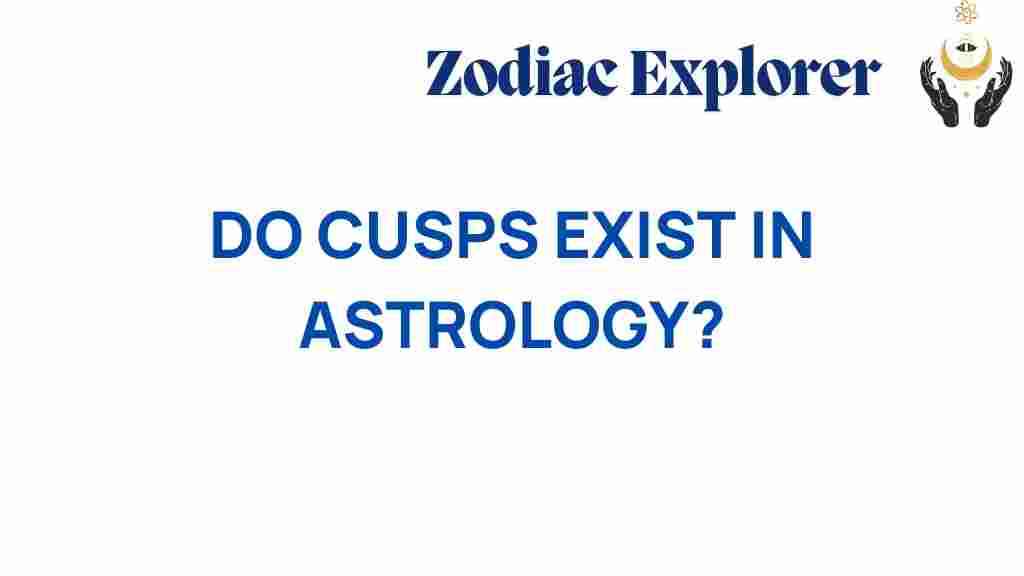The Enigmatic World of Cusps: Do They Truly Exist in Astrology?
Astrology has fascinated humanity for centuries, offering insights into our personalities, relationships, and destinies based on the positions of celestial bodies at the moment of our birth. Among the many intriguing concepts in astrology, the idea of “cusps” stands out. But what exactly are cusps, and do they truly exist in the realm of astrology? This article will delve into the world of cusps, exploring their significance in birth charts and horoscopes, as well as examining the myths surrounding them.
Understanding Cusps in Astrology
In astrology, a cusp refers to the transitional period between two consecutive zodiac signs. Each zodiac sign spans approximately 30 degrees of the celestial sphere, and cusps occur at the beginning and end of each sign. For example, if someone is born on the last day of Aries or the first day of Taurus, they might be considered to be on the Aries-Taurus cusp.
Astrologers debate the validity and impact of cusps on personality traits. Some believe that individuals born on the cusp possess characteristics from both signs, while others argue that a person is definitively one sign based on their exact birth time. Understanding this can be crucial for interpreting astrological charts and horoscopes.
The Significance of Birth Charts
Your birth chart, or natal chart, is a snapshot of the sky at the exact moment you were born. It includes the positions of the Sun, Moon, and planets, which influence various aspects of your personality and life path. For cusp individuals, the birth chart can provide deeper insights into which sign’s attributes may be more pronounced.
- Sun Sign: Your core identity and ego.
- Moon Sign: Your emotional self and inner feelings.
- Rising Sign: The persona you project to the world.
When interpreting a birth chart, paying close attention to the cusps can reveal unique blends of energy. For instance, someone born on the cusp of Gemini and Cancer might exhibit both Gemini’s communicative nature and Cancer’s nurturing tendencies.
Celestial Influences on Cusps
Understanding the celestial influences at play is essential for grasping the concept of cusps in astrology. The planets and their positions can significantly affect how cusp traits manifest in an individual. Here’s how:
- Planetary Rulership: Each zodiac sign is ruled by a specific planet, which influences the traits associated with that sign.
- Aspect Relationships: The angles between planets can either enhance or diminish the qualities of the cusp signs.
- Transits: The movement of planets through the zodiac can activate different aspects of a cusp-born person’s chart.
Astrological Myths Surrounding Cusps
Several myths surround the idea of cusps that can lead to misconceptions. Here are some common astrological myths:
- Myth 1: People born on cusps are not one sign but two.
- Myth 2: Cusps make individuals more compatible with signs from both sides.
- Myth 3: Every person born on a cusp possesses identical traits from both signs.
While cusps can blend characteristics, the belief that individuals embody traits from both signs is not universally accepted among astrologers. Many argue that the exact time of birth is crucial for determining one’s primary zodiac influence.
Examining Compatibility on the Cusps
Compatibility is a significant aspect of astrology, often explored through horoscopes and relationship dynamics. Those born on the cusps may exhibit unique compatibility traits due to their dual influences. Here’s how to examine compatibility for cusp individuals:
- Know Your Signs: Understand the primary sign and the cusp sign to gauge compatibility accurately.
- Consider Moon and Rising Signs: These aspects can influence emotional and interpersonal dynamics.
- Look at Elemental Forces: Signs belonging to the same element (Fire, Earth, Air, Water) often have natural compatibility.
For example, a person born on the Aries-Taurus cusp may find compatibility with both fiery and earthy signs, making them more versatile in relationships.
Step-by-Step Process to Determine Your Cusp Status
If you’re curious whether you or someone else is born on a cusp, follow these steps:
- Check Your Birth Date: Identify your birth date and see if it falls within the last few days of one sign or the first few days of another.
- Know Your Birth Time: The exact time of birth is crucial as it determines your true Sun sign.
- Consult an Astrological Chart: Use an astrology website or consult an astrologer to generate your birth chart.
- Interpret the Chart: Look for the Sun’s position in the chart to confirm if you are indeed on a cusp.
Troubleshooting Common Cusp Confusions
Many people have questions and concerns about cusps. Here are some common troubleshooting tips:
- Birth Time Accuracy: Ensure your birth time is accurate, as this can determine your true Sun sign.
- Understanding Chart Elements: Familiarize yourself with astrological symbols and terms to interpret your chart better.
- Seek Professional Insight: If confused, consider consulting a professional astrologer for personalized insights.
For additional resources on astrology and birth charts, you can check out this astrology guide.
Conclusion: The Mystique of Cusps in Astrology
The concept of cusps in astrology adds a layer of complexity and intrigue to understanding zodiac signs. While there are many debates about their significance, individuals born on cusps often find themselves embodying traits from both signs. Whether you believe in the blending of energies or strictly adhere to the notion that each person belongs to one sign, the exploration of cusps can enrich your understanding of astrology.
In the end, astrology is a personal journey, and whether you identify with your cusp or not, the celestial influences at play can guide you in navigating your life and relationships. Embrace the mystery of the stars, and remember that your birth chart, with its unique combinations of signs and planetary influences, is a powerful tool for self-discovery.
For more insights on zodiac signs and compatibility, explore our comprehensive astrology resources.
This article is in the category Myths and created by ZodiacExplorer Team
